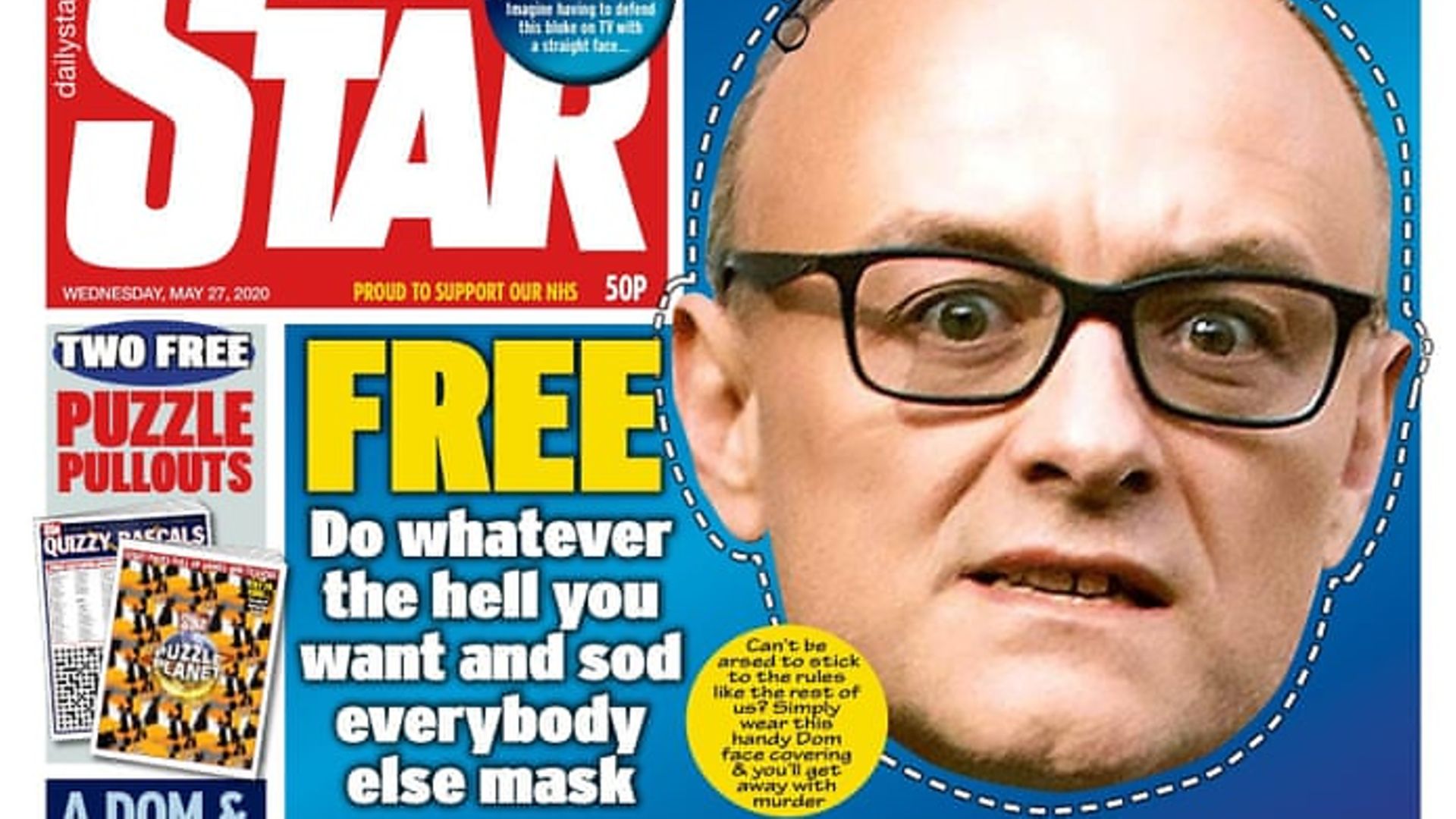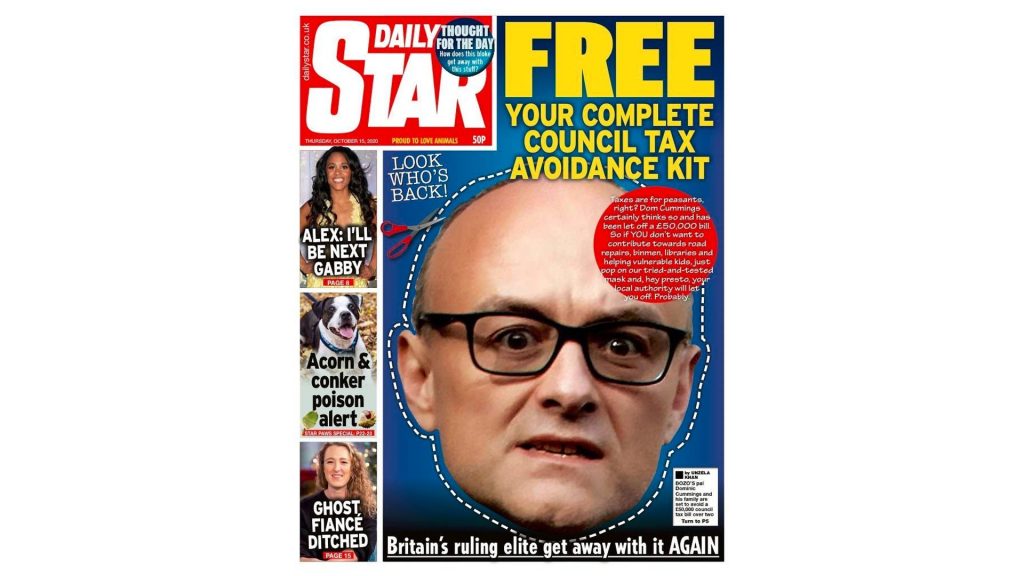
LIZ GERARD on how the Daily Star became the voice of the people – while The Sun speaks for Boris Johnson alone.
The Daily Star speaks for the nation. Who would have thought it?
Fleet Street’s most downmarket tabloid is the country’s acknowledged expert on giant mutant rats, psycho seagulls and lager lout wasps. It knows everything there is to know about killer storms, killer spiders and killer clowns. But politics? Hardly!
Those ‘clowns’ – people dressing up like horror film characters to scare, rather than kill, shoppers – tend to make their appearance at this time of year, conveniently in time for Halloween. But the Star’s clown season started early this year, and while it hasn’t gone so far as to claim that the current crop are killers, it does paint them as a dangerous joke.
These are the jokers in “Boris Johnson’s lying circus”: Bozo, Dunce Williamson and Coco Hancock, plus “Dom and dumber” – the man many would see as the ringmaster and his foreign secretary namesake.
The Star is doing what all newspapers claim to do (but mostly don’t): calling those in authority to account. And doing so with wit and panache through a series of front pages on which comic strip speech bubbles, photoshopped costumes and cartoon labels are all deployed to send a strong message without coming across as preachy.
The result has been some front covers that sit comfortably in the same league as Private Eye and Chris Barker’s glorious efforts for this newspaper. Covers that are being noticed by the aristocracy of political journalism, including the Today programme and Jim Pickard of the FT.
What’s more, it is treating its readers with respect, rejecting the snooty assumption that they wouldn’t know or care who Dominic Cummings was. If they didn’t before the Barnard Castle escapade, they certainly do now. They may even walk around looking like him, given the number of cut-out-and-keep Dom masks the paper has published. Indeed, the Star is so confident that Cummings is now instantly recognisable that it superimposed his face on to a passport control picture illustrating the chaos faced by summer holidaymakers as quarantine rules chopped and changed.
Of course the paper hasn’t completely changed its diet. These political punches are occasional treats, offering a welcome variation from the usual menu of “Prem aces”, reality TV stars and the weather. But they have become more frequent through the pandemic.
When the prime minister first addressed the nation in early March, urging people to wash their hands while singing Happy Birthday, the Star picked up on the call for retired NHS workers to return to the frontline with a Dad’s Army themed front page, a madcap Johnson dressed up as Corporal Jones crying “Don’t panic, don’t panic”. The presentation was irreverent, but the text was straight; neither critical nor fawning.
In the days that followed, each new measure was given similar treatment: an “I’m gonna have to talk to the missus” speech bubble when the football was called off; a Kitchener-style poster telling people “Your country needs you to naff off home” when lockdown started. From the government’s point of view, the paper was onside; the only people under fire were “bog-roll hoarders”, “morons” who drove miles to beauty spots (not Cummings – yet) and “wasters” who panic bought too much food and then had to throw it away.
By April, though, when promised tests for NHS staff were not forthcoming, it began to lose patience, and the Johnson clown, with his multicoloured hair and red nose, made his first appearance, alongside a headline “Now get a bleedin’ grip, Bozo”.
The Sun also majored on NHS workers the same day. Not because they needed tests so that they could work, but because they needed a “Clap of honour”. “Applaud NHS heroes tonight and every Thursday at 8pm” the paper ordered its readers. While noting in an orange roundel that it had been the UK’s deadliest day, with 563 deaths. At least it wasn’t a “virus” starburst, the paper’s preferred way to update readers on the soaring toll.
Within a couple of days the prime minister had been taken to hospital and the Sun had taken to bossing its readers about. They must pray for Boris, they must help NHS heroes, and most of all, they must clap, clap, clap every Thursday. The Queen, the Duke of Edinburgh, the Union Flag, Captain Tom were all wheeled out as the Sun took up Johnson’s Second World War rhetoric and ran with it: plucky Brits would show the Blitz spirit and see off this Johnny Foreigner virus.
In its 100 or so Covid splashes, the Sun has been more loyal than Johnson could ever have hoped with its “Don’t worry, everything will be all right” approach, dutifully giving full welly to every prime ministerial pronouncement and promise. Its biggest concern seems to have been not the death toll or the job losses, but whether readers would be able to throw beer down their necks and darts at a wall down the old Fox and Firkin. More than 10% of the lead stories have been about pubs, most with truly imaginative headlines such as “Ale meet again”, “It’s sup to you” and “Tipple whammy” – that good news day in June when brewers were delivering 250 million pints to pubs, Easyjet were resuming holiday flights and someone had predicted there would be “zero deaths” in July. Really?
Through all of this, the Sun has questioned the government’s performance on its front page barely half a dozen times (four of them in one week last month – perhaps someone important was on holiday) and one of those was about the confusing rules for people who wanted to go to the pub (a “Glugger’s muddle”).
The Star, meanwhile, has run about 80 Covid leads, preferring stories about the impact of the virus on soap stars, panto dwarfs and dogs to regurgitating Downing Street press releases. As it is probably not at the top of Number 10’s list of influential political journalists to be offered special titbits, it does not depend on Cummings-Cain briefings for scoops and so has no fear of being shunned if it publishes something unfriendly.
And when it comes to Cummings, it has certainly been unfriendly. Starting in May with that Rose Garden performance. Everyone put it on the front page, most as the main story. The Sun, in common with the Telegraph and Express, led on shops reopening, relegating Cummings to a ‘puff’ with the headline “I did what was right for my family and my country”. The Star led on British trophy hunters with a dead lion, but put Cummings at the top alongside a picture of a crowded beach “madness” and the headline “Dom says it’s fine”.
With half the country baying for Cummings to be sacked, the Sun decided to let the matter drop. Not the Star. It came out with a priceless “Don’t drive if you’re blind” front page and the first of its cut-out Dom masks – or as it described it a “FREE do whatever the hell you want and sod everybody else mask”.
Since then the Star, no leftie fan of wokish snowflakery, has joined the Mail as unexpected critic, rigorously challenging the government’s strategy and competence. It has also joined the Mirror and the Guardian in directly targeting the man in the shadows behind the government and last week may well have seen its finest hour.
After the Barnard Castle controversy, the Northern Echo did a bit of digging and discovered that the “sort of concrete block” lodge that Cummings had stayed in during lockdown had been built without planning permission. Then it established that the cottage and another building on his parents’ farm, had not been subject to council tax when they should have been and that up to £50,000 in back tax had been written off.
The Mirror, Guardian and Telegraph followed up the story and gave it a little space. The Sun, Times, FT, i, Metro, Mail and Express wrote nothing. The Star splashed on it. Few things irritate the British public more than the notion of “one rule for the elite, another for the rest of us”. Every newspaper editor knows that and every newspaper editor must recognise that the Dominic Cummings’ story would resonate and rankle in every home in the country. To ignore it was a dereliction of duty.

Editor-in-chief Jon Clark and his team understood that. The Sun of the 1980s and 1990s, under Kelvin Mackenzie, would have understood that. He’d have published the story, regardless of the fact that it was harmful for a government generally supported. In those days, the Sun was the most popular paper in the country with sales approaching 5m. Today it has lost its crown to the Mail and declines to publish its circulation – widely believed to be below a million – regarding it as a “commercial secret”. The whole industry is in decline, but the Sun’s fall is at least in part down to its relentless self-referencing, self-important self-absorption and to its slavish propagandising for the government.
Stale and pale, the Sun speaks for Boris; sparky and larky, the Star speaks for the people.










